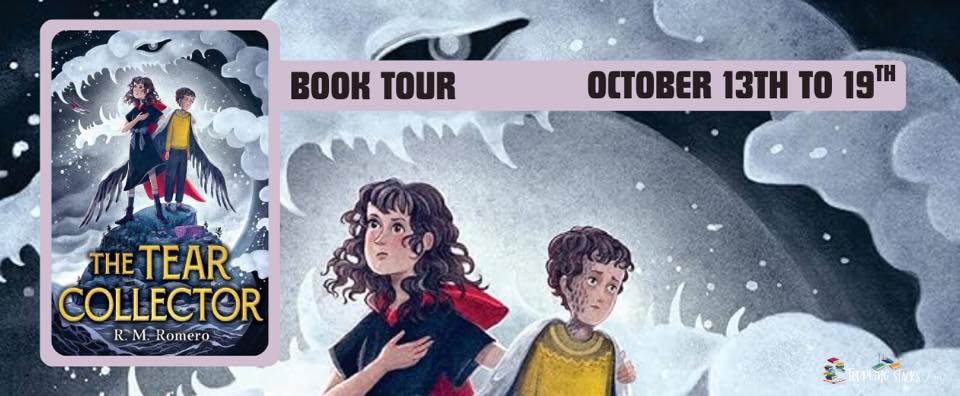
Blog Tour & Book Recommendations: Climate Change, Body Horror, and the New Wave of Cli-Fi
It’s here. It’s storm surge and heatwaves, poisoned water and burning skies. It’s also deeply personal, affecting our bodies, our families, and our sense of safety. And in fiction, especially speculative and horror fiction, the climate crisis becomes not just a backdrop, but the monster itself.
The rise of cli-fi (climate fiction) and eco-horror reflects the truth we already know: environmental collapse doesn’t happen equally. It preys on those already made vulnerable by race, gender, disability, class, or geography. These books don’t look away. They lean in, exploring what survival looks like in worlds where the systems we were told to trust have failed, and nature is no longer passive.
Here are several titles that use body horror, dystopia, and speculative transformation to tell urgent stories about a planet (and a people) on the edge.

The Tear Collector
by R.M. RomeroPublished by: Little Brown Young Readers
on October 14, 2025
Bookshop
Goodreads
This darkly fantastical climate change tale explores hope, memory, and what really makes a monster—set after the end of the world.
Climate change culminated in the Flood, an enormous wave that wiped out entire countries. Malka and her younger brother Ezra survived and now live with Dr. Jonas Hollman on the Island, the only piece of land left on Earth. Scavenging useful things from the shoreline under the watchful eye of the Island’s sinister leader Mr. Gray, Malka and her family get by. Barely.
But an illness called the Sorrow is changing people into monsters when their memories of the Mainland grow too sad…and Ezra is the latest to get sick. Desperate not to lose her brother, Malka throws herself into helping “Uncle” Jonas with his research to find a cure.
Then her family’s dismal lives are turned upside down by the mysterious Olivia, who crashes a plane on the beach. More people are out there, she says. The world isn’t lost forever. To save Ezra and the other Islanders, Malka will have to uncover the secrets of her flooded world—and the lies even the people she loves have told her about the true nature of the Sorrow.
R.M. Romero tackles our fear and anxiety surrounding climate change and weaves it through with hope in this beautifully told adventure that will resonate with readers young and old.
Climate Change, Body Horror, and the New Wave of Cli-Fi
The Tear Collector by R.M. Romero
After the Flood drowns entire countries, Malka and her younger brother Ezra survive on the Island, the last scrap of land left on Earth. Life is brutal under the watch of Mr. Gray, and when Ezra falls ill with the Sorrow (a sickness that transforms grief into monsters), Malka turns to a desperate search for a cure. But the arrival of a stranger with news of survivors beyond the sea threatens to upend everything she thought she knew about the Flood, the Island, and the nature of the Sorrow itself.
Why it matters:
R.M. transforms climate grief into a literal monster, weaving eco-horror with mythic fantasy to ask what makes us human when hope feels drowned. Both terrifying and tender, The Tear Collector offers a vision of resilience at the end of the world.
They Fear Not Men in the Woods by Gretchen McNeil
The forests of Barrow, Washington, are thick with grief and secrets. When Jen Monroe’s father, an outspoken forest ranger who vanished seven years earlier, is declared dead, she returns home unwilling to believe it. A memorial camping trip becomes something else entirely when the woods close in, revealing horrors older and more merciless than human greed.
Why it matters:
Gretchen transforms the Pacific Northwest wilderness into a stage for grief, rage, and ecological dread. What begins as one woman’s search for her father becomes a descent into a forest that refuses to forget, or forgive. The question lingers long after the last page: when the land remembers what we’ve done to it, how will it make us pay?
The Dead of Summer by Ryan La Sala
The island of Anchor’s Mercy has always been a queer refuge. But when something glowing and deadly begins rising from the ocean, the boundary between utopia and apocalypse dissolves. Told through interviews, transcripts, and mixed media, this novel unspools the horror of a radiant plague that infects bodies, memories, and history itself.
Why it matters:
Ryan blends body horror with climate dread, imagining a world where the very water turns against us, and erases the stories we need to survive. What happens when paradise becomes toxic?
They Bloom at Night by Trang Thanh Tran
A red algae bloom has overtaken Mercy, Louisiana. The town is submerged, the wildlife is mutating, and Noon’s life, already fractured by a trauma no one talks about, is unraveling. When the town’s leader demands she and her mother hunt down the monster in the water, Noon must decide whether to fight, flee, or finally face the thing taking shape inside her.
Why it matters:
This is climate fiction rooted in rage, reclamation, and transformation. As the town drowns under environmental and social rot, Noon’s body becomes the site of resistance. The horror here isn’t just the storm, it’s what comes after.
Climate of Chaos by Cassandra Newbould
In post-storm Seattle, medical care is a luxury controlled by Aegis Corp, and survival means selling your labor or your body. When disabled teen Fox LaRosa’s sister is captured by the healthcare-industrial complex, she infiltrates the elite domes to get her back. What she finds threatens to unravel not just the system, but everything she thought she believed about her own side.
Why it matters:
Set in a world where climate catastrophe and capitalist collapse go hand in hand, this dystopian thriller tackles medical debt, environmental injustice, and the weaponization of care. With a disabled protagonist at the center, it asks: what does resistance look like when every system is broken?
The Girl in the Creek by Wendy N. Wagner
Freelance writer Erin Harper returns to Faraday, Oregon, to investigate her brother’s mysterious disappearance in the nearby Clackamas National Forest, a place notorious for its abandoned mines, missing persons, and a hotel overrun with strange fungi. When Erin discovers a missing girl’s body in the creek, it vanishes from the morgue, and soon, the forest’s spores begin to feel dangerously alive.
Why it matters:
This eerie Pacific Northwest cli-fi blends cosmic horror with environmental dread, exploring what happens when nature doesn’t just reclaim the land…it fights back. Perfect for fans of Jeff VanderMeer and T. Kingfisher, The Girl in the Creek is a haunting reminder that the line between survival and surrender in the age of climate collapse is perilously thin.
These books aren’t escapism; they’re reckoning. Through floods and fire, spores and survival, they explore how the climate crisis reshapes not just landscapes, but lives. Whether it’s corporate controlled domes, forests that devour, or the quiet collapse of the world we know, each story reminds us that horror isn’t always fictional, and that the fight for the future is already here.
Follow the Tour
October 13th
Mx. Phoebe’s Viewpoint – Review, Favorite Quotes
The Book Dutchesses – Promotional Post
October 14th
Boys’ Mom Reads! – Review
The Clever Reader – Promotional Post
October 15th
Confessions of a YA Reader – Promotional Post
October 16th
The Violet West – Top 5 Reasons to Read The Tear Collector
October 17th
Kim’s Book Reviews and Writing Aha’s – Review, Tik Tok
Bookcrushin – Promotional Post <– You Are Here
October 18th
Books1987 – Promotional Post
October 19th
TheMoonPhoenix – Review, Playlist








